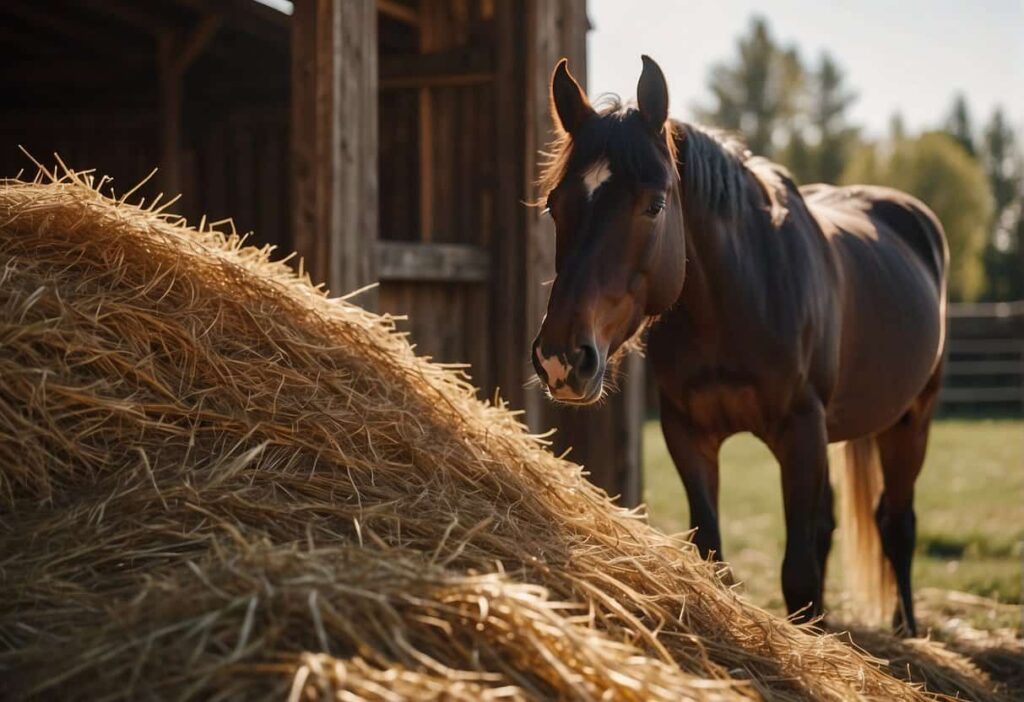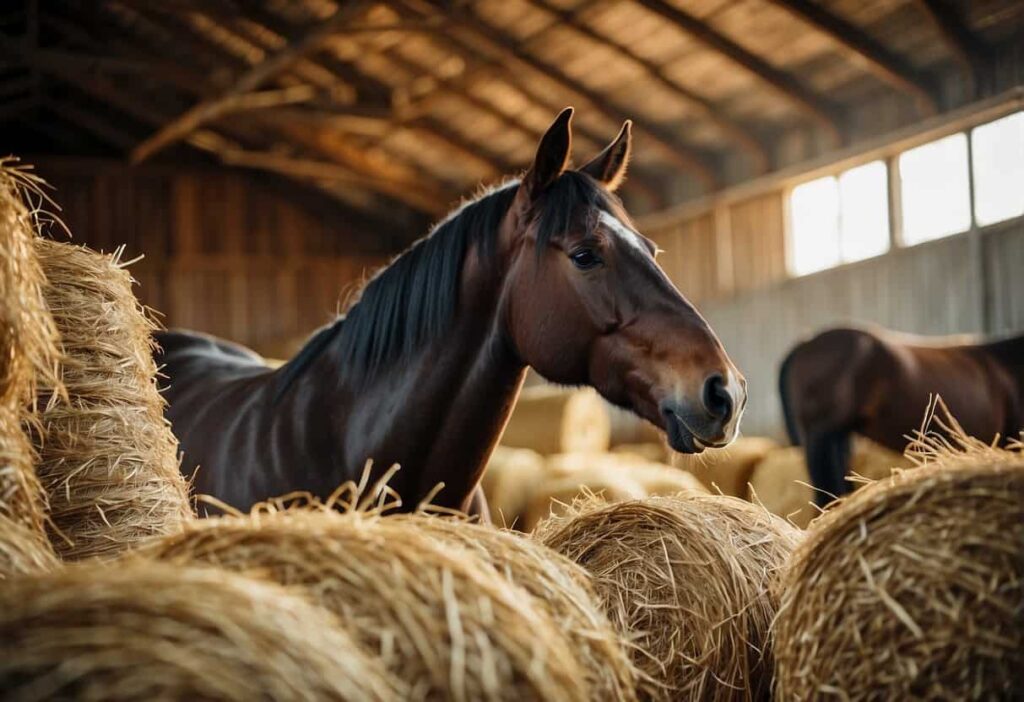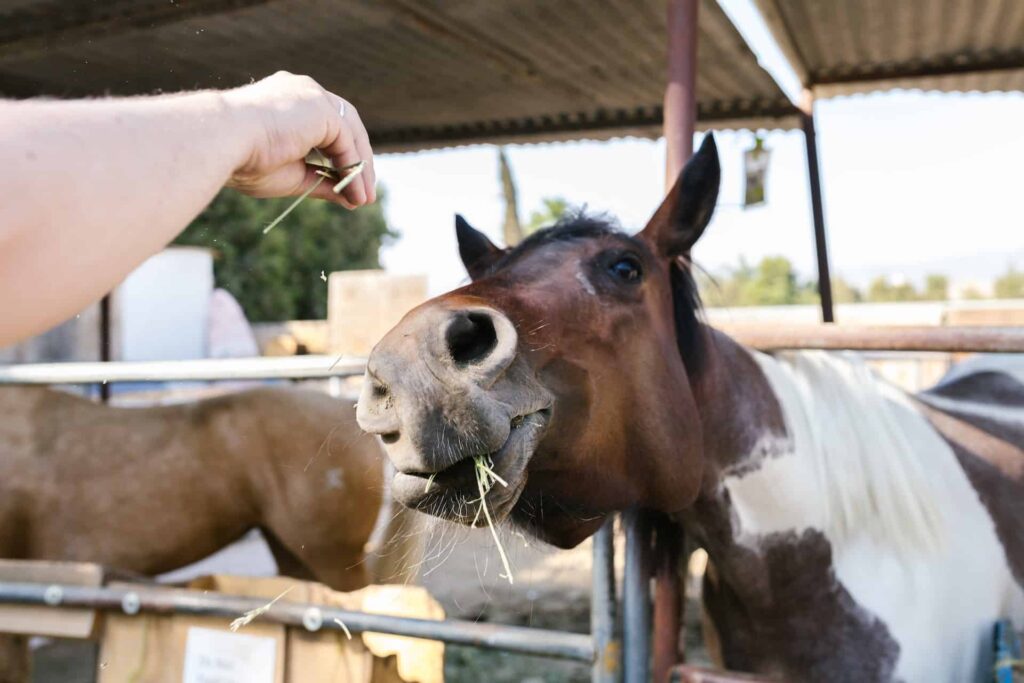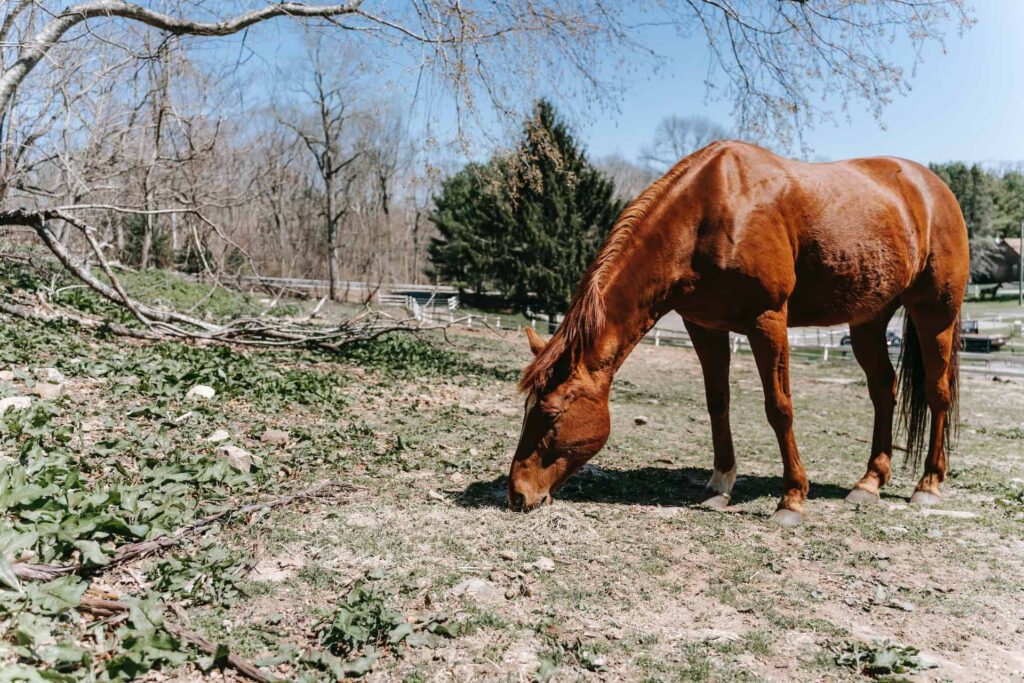Horses are large animals with considerable nutritional needs to maintain their health and well-being. One of their primary sources of nutrition is hay, which provides the necessary fiber and nutrients for a balanced diet. The amount of hay a horse consumes can vary depending on various factors such as age, weight, activity level, and overall health.
Understanding the nutritional requirements of a horse is vital for proper care and feeding. Providing the right amount of hay ensures that horses receive the essential nutrients they need for maintaining optimal health, proper digestion, and supporting their daily activities. Hay quality and type also play crucial roles in determining the appropriate amount to feed a horse.
To calculate how much hay a horse needs, typically, an 1100-pound horse eats 2% of its body weight per day in hay. For example, a horse of this size will consume around 4000 pounds (2 tons) of hay annually. Adjustments to feeding practices and amounts should be made according to the individual horse’s needs and consultation with equine professionals.
Key Takeaways
- Horses require hay for proper nutrition, and the amount consumed depends on factors like weight, age, and activity level.
- Hay quality and type influence the nutritional value and the appropriate amount to feed a horse.
- An 1100-pound horse typically consumes about 2% of its body weight in hay daily, but adjustments in feeding practices should be tailored to the individual’s needs.
Understanding Horse Nutrition
Importance of Forage in Diet
Forage, such as hay and grass, plays a crucial role in meeting a horse’s nutritional needs. It provides essential fiber, which promotes a healthy digestive system. The horse’s digestive system is designed for a diet rich in forage, and feeding insufficient amounts of forage can lead to digestive disorders. (source)
When horses graze naturally, they spend most of their time eating small quantities of forage throughout the day. This natural consumption pattern should be considered when providing hay or other fiber sources, ensuring that the horse has access to forage for at least 15–20 hours per day.
Energy and Protein Requirements
The primary function of hay in a horse’s diet is to provide energy. The energy requirement for horses varies depending on factors such as age, weight, level of activity, and reproductive status. Adult horses have a lower energy requirement compared to growing horses or pregnant mares.
Protein, an essential nutrient, is also a critical component of an appropriate diet for horses. It helps to support muscle growth and maintain overall body condition. The body condition score (BCS) is a useful tool to assess a horse’s current nutritional status and adjust feeding strategies accordingly.
Horses have varying protein requirements based on their life stages, including growth, maintenance, and reproduction. Generally, a mature horse requires 10–12% protein, while young, growing horses may need between 14–16% protein in their diet.
Vitamins and Minerals Essential for Health
Besides energy and protein, horses also need a balanced intake of vitamins and minerals to maintain their overall health. Essential vitamins like vitamins A, D, and E are vital for a horse’s immune system, vision, and bone development.
Minerals such as calcium, phosphorus, magnesium, and zinc play an important role in the horse’s bone and muscle function, as well as in enzyme activity and metabolic processes. It is essential to ensure the horse receives a balanced and varied diet to meet their nutrient requirements.
Understanding horse nutrition involves a comprehensive approach to feeding that encompasses the essential components of forage, energy, protein, vitamins, and minerals. By meeting the nutritional needs of a horse, owners promote optimal health, growth, and performance in their equine companions.
Factors Influencing Hay Consumption

The Role of Age and Activity Level
Hay consumption in horses can be influenced by several factors, including age and activity level. Younger horses and those engaged in regular exercise may have higher metabolic rates and increased energy demands. As a result, these horses may require more hay to fuel their activities. In contrast, older or less active horses usually have lower energy demands and may consume lesser amounts of hay. (Source)
Impact of Horse Size and Breed
Another factor that can impact hay consumption is the size and breed of the horse. Larger breeds typically require more hay than smaller breeds due to their greater body mass. Horses with longer body lengths will also consume more hay due to their increased body weight. It is important to note that individual metabolism rates among different breeds could also cause variations in hay intake.
Health and Body Condition Considerations
The health and body condition of a horse can also significantly affect hay consumption. Horses that are underweight or recovering from illness may require more hay to regain lost body weight and build muscle mass. Conversely, horses that are overweight or suffering from health issues such as metabolic disorders may need a reduced amount of hay to maintain a healthy weight.
Some examples of factors influencing hay consumption in horses include:
- Age: Younger and more active horses may require more hay than older or less active horses due to their higher energy demands.
- Size: Larger breeds or horses with longer body lengths typically consume more hay due to their greater body mass.
- Breed: Individual metabolism rates among different breeds may lead to variations in hay consumption.
- Health: A horse’s health and body condition can greatly impact the amount of hay required, with underweight or recovering horses needing more hay, and overweight or horses with health issues needing less.
Considering the varying factors, it is essential to monitor each horse’s individual needs when determining their optimal hay consumption. A proper and balanced diet not only maintains overall health but also aids in supporting various activities and recovery from health concerns.
Types and Quality of Hay
Comparing Legume and Grass Hays
There are two main types of hay that horses commonly consume: legumes and grasshays. Legume hay, which includes alfalfa and clover, is known for its higher protein content and overall energy density compared to grass hay, such as timothy and orchard grass. It’s essential to consider the horse’s energy needs when deciding between legume and grass hay because alfalfa tends to provide more calories per pound than grass hay.
Legume hays are typically:
- Higher in protein
- Rich in calcium
- More energy-dense (higher in calories)
Grass hays, on the other hand, generally offer:
- Higher fiber content
- Lower calorie density
Identifying Good Quality Hay
Good quality hay is crucial for maintaining a horse’s overall health. Factors to consider when evaluating hay quality include:
- Color: Optimal quality hay should be green, as yellow or brown hay may indicate sun-bleaching or mold.
- Texture: Soft and pliable stems are easier for horses to ingest and digest.
- Aroma: A fresh, sweet smell indicates good quality hay, while a musty or moldy odor may be a sign of spoilage.
- Absence of dust and mold: This is important for avoiding respiratory issues in horses.
- Presence of leaves: A high leaf-to-stem ratio suggests a more nutritious hay.
Effects of Maturity on Nutritional Value
The nutritional value of hay is closely tied to its maturity when harvested. As plants mature, their fiber content increases while their protein and energy content decrease. Therefore, it is essential to consider the maturity of hay when selecting it for horses. A more mature hay might be higher in indigestible fiber, which is essential for horses’ digestive health, but lower in protein and energy.
Selecting the right type of hay requires balancing horses’ energy needs, fiber intake, and overall nutritional requirements. Recognizing good quality hay and understanding the effects of plant maturity on nutritional value can help horse owners make informed decisions about the optimal feed for their animals.
Calculating Hay Requirements
Daily Hay Intake Based on Body Weight
When determining how much hay a horse needs, it is essential to consider the animal’s weight. Generally, horses should consume about 1.5-2% of their body weight in forage daily. For example, a 1,000-pound horse would require 15-20 pounds of hay per day. Hay is often sold in bales, with each bale consisting of several flakes.
One flake typically weighs around 5 pounds, making it easy to measure and serve the appropriate amount of hay in meals or for grazing. The National Research Council recommends basing hay intake on body weight for optimum health and nutritional balance.
Adjustments for Specific Dietary Needs
Not all horses have the same dietary needs. Factors like age, activity level, and health conditions can influence a horse’s hay consumption. For instance, horses with high energy requirements due to athletic performance may need more hay than sedentary ones. Seniors may require more easily digestible forage such as chopped hay or hay pellets to avoid digestive issues.
Horses with health conditions like laminitis require a carefully managed diet with low-sugar hay. It is crucial to consult with a veterinarian or equine nutritionist when adjusting hay intake for specific dietary needs to ensure the horse’s overall health and well-being.
Regular Monitoring and Adjusting Portions
As grazing animals, horses benefit from having access to forage like hay throughout the day, rather than only during set mealtimes. Providing hay in slow feeders enables horses to graze leisurely, mimicking their natural feeding habits and reducing the risk of developing gastric ulcers or other digestive disorders.
Regularly monitoring a horse’s body weight and condition is critical for maintaining optimal health. Adjust hay portions as needed to ensure they maintain an appropriate body weight. It is essential to consider changes in activity level, health conditions, or fluctuations in the quality of the hay itself. By paying close attention to the horse’s needs and responding accordingly, owners can provide their animals with a balanced and appropriate diet.

Feeding Practices and Considerations
Meal Frequency and Portion Control
When determining how much hay a horse should eat, one must consider the horse’s health, body condition score, and the appropriate meal frequency. Horses typically eat between two to four percent of their body weight in forage each day. It is important to split this amount into multiple small meals throughout the day, such as two or more meals a day. This is because the horse’s digestive system is designed to process small amounts of forage continuously. Feeding larger meals less frequently could negatively impact the horse’s digestive health.
Managing Forage Access and Preventing Boredom
Horses should have free access to hay if possible, to closely mimic their natural feeding behavior. This practice can also help prevent boredom and reduce the risk of developing vices such as cribbing or weaving so long as the horse has access to a variety of hay types and fresh grass. However, not all horses can graze continuously. For those with restricted access to forage, providing slow-feed hay nets or other slow-feeding devices can help prolong feeding time and reduce boredom.
Supplemental Nutrition and Concentrate Feeding
While forage should be the primary source of nutrition for horses, some may require additional nutrients depending on their specific needs, workload, and the quality of forage available. In these cases, feeding supplements or concentrates may be necessary.
Supplements can be used to provide essential vitamins, minerals, or amino acids that may be lacking in the horse’s diet. Concentrates, such as pelleted or grain-based feeds, can be used to provide digestible energy for horses with increased caloric requirements, such as performance horses or those with difficulty maintaining weight.
When choosing supplemental nutrition, the horse’s individual needs should be carefully considered, and adjustments to their feeding regimen should be made gradually to avoid causing digestive upset or exacerbating any existing health issues.
Care and Storage of Hay
Proper care and storage of hay are crucial for maintaining its quality and ensuring it remains palatable for horses. This is important regardless of the horse’s age, workload, or breed, as it impacts overall health. There are a few key factors to consider when caring for and storing hay, such as preserving nutritional integrity and preventing spoilage.
Preserving Nutritional Integrity
To maintain the nutritional value of hay, it is essential to store it in a cool and dry environment. Hay bales should be kept off the ground by using pallets or a raised platform, allowing for proper air circulation and preventing moisture from accumulating. This helps to retain vital nutrients, such as vitamins and minerals, which are crucial for a horse’s health.
For senior horses or those with specific dietary needs, it may be necessary to provide vitamin and mineral supplements in addition to quality hay. Supplementing with vitamins and minerals can help to fill any nutritional gaps in the horse’s diet.
Preventing Hay Spoilage
Prevention of spoilage is another significant aspect of hay care and storage. Spoiled hay can lead to an increased presence of dust and mold, which can cause respiratory issues and other health problems for horses. Spoilage can also result in reduced palatability, meaning that horses might refuse to eat the hay.
To prevent hay spoilage, always store hay in a well-ventilated area, away from direct sunlight and moisture. Keep hay bales covered with a waterproof tarp or stored in a hay shed to protect them from rain and dampness. Also, be sure to regularly inspect the hay for signs of mold, pests, or any other issues that might compromise its quality.
Proper care and storage of hay are essential for maintaining its nutritional value and preventing spoilage. By following these guidelines, you can help ensure the horse’s hay remains palatable and provides the necessary nutrients for optimal health.
Consulting with Equine Professionals
Regular Health Checks and Dietary Planning
It is crucial to involve equine professionals, such as veterinarians and equine nutritionists, in the horse care process to ensure the well-being and overall health of your horse. Regular health checks can help identify any issues related to digestion or nutritional deficiencies in your horse’s diet. A balanced diet for a horse typically consists of roughage, such as hay, and may include grains to meet their nutritional needs.
Equine professionals can help determine the appropriate amount of hay your horse should eat. This can vary depending on factors like the horse’s size, age, activity level, and digestive system. By observing your horse’s body condition and monitoring its weight, professionals can provide valuable guidance on how much hay to feed. Moreover, they can also recommend the type of hay that is best suited for your horse’s needs.
Recognizing the Signs of Nutritional Deficiencies
Equine professionals play a significant role in recognizing the signs of nutritional deficiencies in horses. They can identify symptoms such as weight loss, poor coat quality, or changes in the horse’s behavior.
Some common signs of nutritional deficiencies include:
- Weight loss: A horse that loses weight rapidly or consistently might be lacking sufficient nutrients in its diet, particularly roughage.
- Lethargy: Lack of energy and enthusiasm for work may indicate that the horse isn’t receiving enough nutrients or has an issue with its digestive system.
- Poor coat quality: Dull or patchy hair may be indicative of nutritional deficiencies or digestion problems.
- Behavioral changes: Horses that show changes in their temperament or exhibit unusual behaviors may be suffering from nutritional imbalances.
By consulting with equine professionals and addressing these symptoms, you can ensure your horse’s health and well-being. Moreover, they can help adjust your horse’s diet accordingly to resolve any nutritional deficiencies.
Cost Considerations for Horse Owners
Estimating Annual Hay Costs
When it comes to horse ownership, one of the major expenses is the cost of hay. Horses consume approximately 1.5% to 3% of their body weight in hay each day, depending on their age, activity level, and other factors. Therefore, a 1,000-pound horse will eat between 15 and 30 pounds of hay daily.
To estimate the annual hay costs, you’ll need to take the following into account:
- Weight of hay: Determine the total weight of hay your horse will consume over a year. For example, if your horse eats 20 pounds of hay per day, that’s about 7,300 pounds annually.
- Price per pound: Hay prices can vary significantly depending on location, quality, and time of year. Hay can range from $3 to $9 per 55-pound bale. To estimate cost, determine the price per pound of hay in your area.
- Total annual cost: Multiply the total weight of hay needed by the price per pound to find the total annual cost for hay.
Balancing Quality and Budget
It’s important to balance quality and budget when selecting hay for your horse. High-quality hay will provide essential nutrients, promote better health, and reduce the need for additional supplements. Some factors to consider when selecting hay are:
- Hay type: Different hay types have varying levels of nutrients. Common hay types for horses include timothy, brome, and orchard grass. Alfalfa is high in protein and calcium but should be balanced with other hay types to avoid excess nutrients.
- Color and smell: Good quality hay should be bright green and have a fresh, sweet smell. Avoid dull hay that has a musty smell, or has visible mold.
- Texture: Quality hay will have thin, pliable stems and leafy, soft leaves. Coarse or thick-stemmed hay may indicate poor quality and be less palatable to your horse.
- Storage: Hay should be stored in a cool, dry place, free from moisture and direct sunlight. Proper storage will prolong the life of the hay and maintain its nutritional value.
- Testing and analysis: If you’re uncertain about the nutritional content of your hay, it’s recommended to have it tested by a professional laboratory. This allows you to confidently provide your horse with the nutrients they need without overspending.
By considering these factors, horse owners can balance the cost and quality of hay, ensuring their horses receive adequate nutrition while staying within budget.

Environmental Impact of Hay Production
Sustainable Farming Practices
Farming practices have a significant impact on the environment, and utilizing sustainable methods can benefit both the ecosystem and the hay production for horses. One such practice is crop rotation, which prevents soil degradation and promotes better nutrient management in the soil. Another technique is integrating cover crops, which helps reduce erosion and enhance soil fertility.
Proper manure management is crucial as well. Properly composting and spreading horse manure can provide valuable nutrients to the soil and reduce the need for synthetic fertilizers. Using nitrogen-conserving feedstuffs in horses’ diets can minimize the environmental impact of nitrogen output on horse operations.
Eco-Friendly Hay Production Methods
To minimize the environmental implications of hay production, multiple eco-friendly methods can be employed:
- Solar-powered equipment: Utilizing solar energy to power hay production equipment can significantly reduce the carbon footprint associated with this process.
- Precision agriculture: Applying modern technologies (GPS, sensors, etc.) to monitor and manage hay fields can increase efficiency and reduce waste of resources like water and fertilizers.
- Preservation techniques: Optimal conditions for hay preservation play a crucial role in ensuring quality forage for horses while also preventing mold growth and reducing the risk of respiratory issues in horses.
- Low-impact harvesting methods: Avoiding heavy machinery that can contribute to soil compaction and erosion will help maintain healthier soil and improve hay production.
In summary, sustainable farming practices and eco-friendly production methods are essential to minimize the environmental impact of hay production for horses. Adopting these practices contributes to healthier soil, resource conservation, and ultimately better quality hay for our equine companions.
Innovations in Horse Nutrition and Feeding
New Forage Alternatives
In recent years, research has led to the development of new forage alternatives for horses. One example is the supplementation of conserved forage such as hay or haylage in the horse’s diet. These preserved forages provide a more consistent source of nutrients and can be adjusted to meet the horse’s specific nutritional requirements.
Some horse owners are also exploring other forage sources like grass silage, which has been shown to provide sufficient energy for horses when properly fed. The popularity of alternative forages reflects the increased emphasis on providing a diverse diet to support overall horse health.
Advancements in Digestive Health Research
As the understanding of equine nutrition and digestion improves, new advancements in digestive health research aim to enhance the horse’s ability to process feed more effectively. For instance, studies have explored the effects of nutritional technology and feed processing on voluntary intake, digest characteristics, and feed utilization in horses. This research helps to identify feeding strategies that can maximize nutrient absorption and minimize digestive disturbances.
Another area of focus is the optimization of gut microflora in horses. By promoting a healthy balance of beneficial bacteria in the digestive system, horses can experience increased nutrient absorption and a reduced risk of colic or other gut-related issues.
The field of equine nutrition and feeding is continuously evolving with the development of innovative forage options and advancements in digestive health research. These efforts aim to provide horses with a well-rounded, balanced, and effective diet, promoting overall health and well-being for these majestic animals.
Frequently Asked Questions
What is the ideal amount of hay per day for an adult horse?
The ideal amount of hay per day for an adult horse generally depends on its weight and activity level. As a rule of thumb, a horse should consume about 1.5% to 2% of its body weight in hay daily. For instance, a 1,000-pound horse would eat 15 to 20 pounds of hay each day. It’s essential to monitor your horse’s body condition and adjust the hay ration as needed.
How should the amount of hay be adjusted for a horse’s weight loss plan?
To help a horse lose weight, the hay intake should be reduced gradually. Consult your veterinarian to determine the appropriate amount of hay required for your horse on a weight loss plan, considering factors like health, exercise, and overall diet.
Can horses maintain a healthy diet with grass alone, or is supplemental hay necessary?
Horses can maintain a healthy diet if they have access to good-quality, abundant pasture. However, during the winter months or in areas with limited grazing, supplemental hay becomes necessary to ensure their nutritional needs are met.
What is the recommended feeding frequency for horses to ensure their well-being?
To promote optimal digestion and well-being, horses should be fed small, frequent meals throughout the day. Ideally, they should have access to forage, like hay or pasture, most of the time to mimic their natural grazing behavior.
How do the hay requirements for horses vary by region, such as in California?
Hay requirements for horses can vary by region due to differences in climate, pasture availability, and the types of hay grown. In California, for example, alfalfa is a common hay source. Horse owners should be aware of the nutritional value of the local hay and adjust their feeding regimens accordingly.
What are the potential risks of feeding a horse too much or too little hay overnight?
Feeding horses too much hay overnight can result in them overeating and potentially contribute to obesity. On the other hand, feeding too little hay may cause them to become hungry and experience gastric ulcers due to prolonged periods without forage. It’s best to provide an adequate amount of hay overnight, ensuring they have enough to graze on throughout the night without overeating.
References
- https://diamondback.ponyclub.org/ContentDocs/31494/Instructional/buying_hay.pdf
- https://books.google.com/books?hl=en&lr=&id=qTtgmCp5izQC
- https://www.sciencedirect.com/science/article/abs/pii/S0737080609006054
- https://books.google.com/books?hl=en&lr=&id=0Ts0dwjv1o4C
- https://www.cambridge.org/core/journals/animal/article/abs/voluntary-intake-and-digestibility-in-horses-effect-of-forage-quality-with-emphasis-on-individual-variability/16BD2811273D3B96CE58C2F029643793
- https://www.sciencedirect.com/science/article/abs/pii/S0737080619306185
- https://www.sciencedirect.com/science/article/abs/pii/S0737080614001737
- https://books.google.com/books?id=LkhuEAAAQBAJ
- https://www.mdpi.com/2076-2615/13/8/1280
- https://books.google.com/books?hl=en&lr=&id=Z408BAAAQBAJ
- https://www.sciencedirect.com/science/article/abs/pii/S0737080615005493
- https://www.sciencedirect.com/science/article/abs/pii/S0377840107002325
- https://www.sciencedirect.com/science/article/abs/pii/S0737080622002763
Last Updated on December 18, 2023 by Nate Dewsbury



